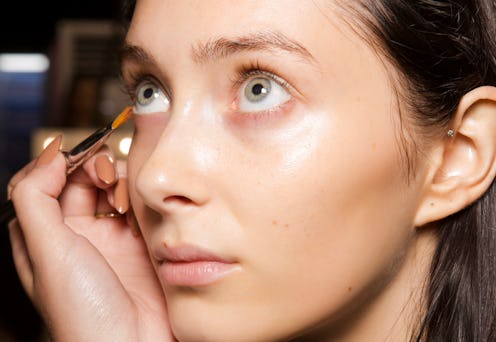(Beauty)
This Is How Dewy Skin Became A Trend

Surprisingly, the breakout trend from last Fashion Week was not the comically large shoulder pads or the oddly chic square-toed shoes, but the healthy-looking skin that dominated the runways. That’s it. That’s the trend: Skin. Slightly shiny skin, glowing the way all sebum-producing skin should. Suddenly, it seemed as if the look was everywhere, begging the question: How do skincare trends during fashion month happen? And how did this dewy aesthetic manage to take over the world?
To hear professional makeup artists tell it, “skin trends” are nothing new. “To start, having worked backstage this long, I can say skin is always a focus,” Fatima Thomas, a Senior Artist with MAC who’s created runway beauty for Missoni and Chromat, tells The Zoe Report. She says that designers traditionally prefer what she calls an “athletic” complexion — fresh and flushed — and not much else, in order to keep the attention on the clothes.
“I think it’s always been there — it’s just that different demographics are now getting on board,” Katie Jane Hughes, the Insta-famous makeup artist known for her perpetually glossy face, agrees in an interview with TZR. Chalk it up to the Instagram influence: The platform broadcasts trends in real time, and since it’s arguably easier (and quicker) to adopt a fresh-off-the-runway beauty trend than a clothing trend, skin has fully stepped into the spotlight.
“It’s kind of a rule that skin should look like skin,” Hughes says — in fact, she says makeup artists are trained to create a very fresh, light finish on models as a baseline. “There’s never an instance where someone would say, ‘Give me heavy, cake-y makeup.' Never."
“What tends to change is the focus of texture and how we represent it,” Thomas explains. “Is it about healthy, athletic skin? Is it about clear, porcelain skin? You can get both, but there’s usually one that stands above the rest for the season.” Right now, that one stand-out skin trend is “beautiful skin that looks balmy, hydrated, and healthy,” Thomas says. “It looks like a great facial and you’re glowing.”
According to Thomas, the finish (velvet, dewy, matte, shiny) usually depends on the season — and how the skin typically behaves during said season. You’re more likely to see velvet-y skin for Fall/Winter, since complexions tends to be a little drier during those months; Spring/Summer collections usually come with a side of shine. “We work with nature; it’s less work to maintain,” the makeup artist says. “It’s nice that [glowing] skin is a ‘trend,’ because it caters to what the skin wants to do. The skin wants to produce oil and it wants to stay hydrated and dewy.”
The fashion designer running the show usually has a say in the models’ skin texture, as well; in some instances, a particular look becomes a brand signature, rather than a one-and-done seasonal trend. “Chanel always goes for velvety skin that looks polished, flushed, but not overly greasy,” Hughes offers as an example.
No matter what the final finish, skin preparation is an integral part of backstage beauty and always has been, say Thomas and Hughes — though the prep stage may seem more visible now with the all-prevailing presence of Instagram Stories. (Not to mention, the sponsorship opportunities for skincare brands. Free pre-show sheet masking session, anyone?)
To this end, Hughes keeps three prep products in her kit at all times: Elemis Dynamic Resurfacing Facial Pads (she’s an Elemis ambassador), Weleda Skin Food, and Bioderma Sensibio H2O Micellar Water. “The peel pads give skin this polished look, like you had a facial,” she says. “Bioderma is the best makeup cleansing water you can buy, and Weleda Skin Food is kind of what’s in everybody’s kit now — you can prep skin with it, use it as a mask, and use it as a highlighter.”
Thomas is always armed with an array of moisturizers and oils to suit each model’s skin type, but calls MAC’s Lightful C Moisture Cream her hero product. “What a leave-in conditioner does for hair, this does for skin,” she says. “Whatever condition your skin is in, this will take it up several notches.”
The Spring/Summer 2020 shows are about to start (New York Fashion Week kicks off on Sept. 5), and makeup artists predict that the glowy, dewy look you’ve come to love isn’t going anywhere. “Artists and consumers alike are really invested in the glow because it looks like skin in its most healthy, pampered state — skin glows,” Thomas says. “Healthy skin doesn’t look matte. It at least has a bit of oil on the surface to protect it.”
With this in mind, the argument could be made that this particular Fashion Week skin trend is more than just aesthetic; perhaps it’s a surface-level manifestation of something deeper. In today’s culture, wellness is more important than ever, and consumers are starting to recognize inner health as the key to an outer glow. The body positivity, skin positivity, self-care movements are growing stronger by the day. Increasingly, women (and men) are turning to makeup as a means of self-expression — not a method for covering up. Really, is it any wonder that the look of effortless, naturally oil-coated skin is in?
Thomas says it best: “Bare, healthy skin puts the focus on the person and not the makeup — and I think that’s something people feel really good about.”